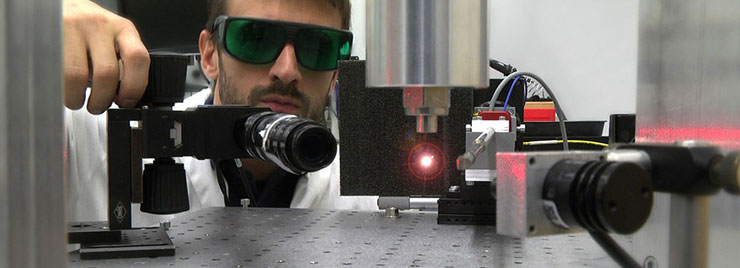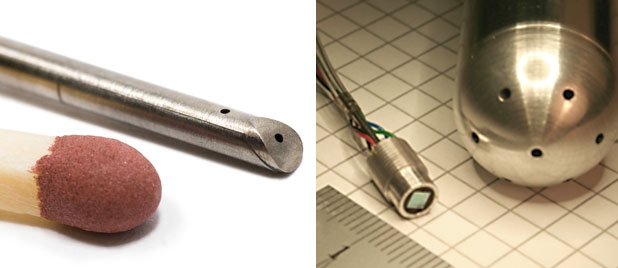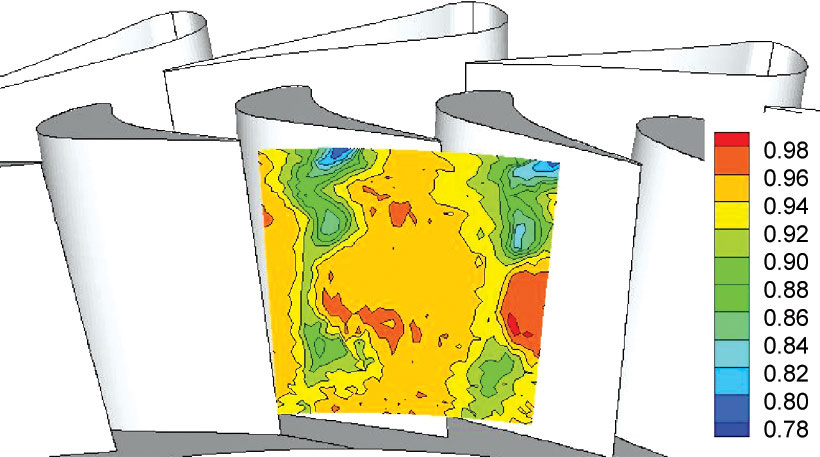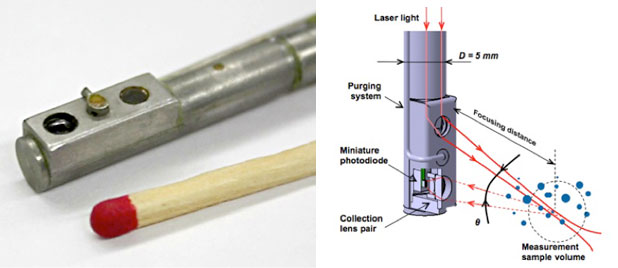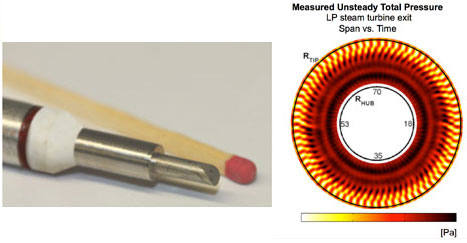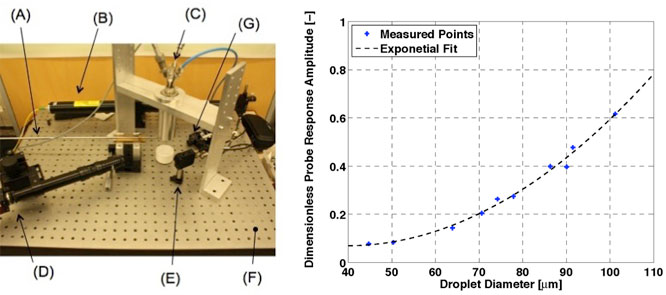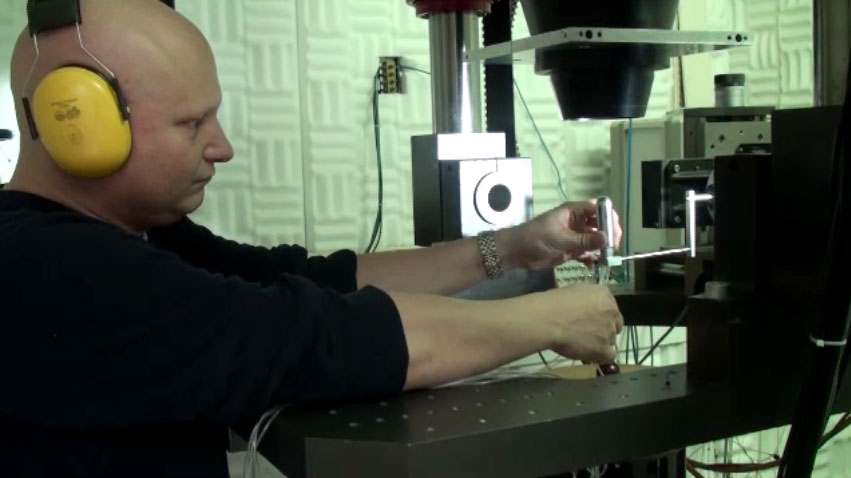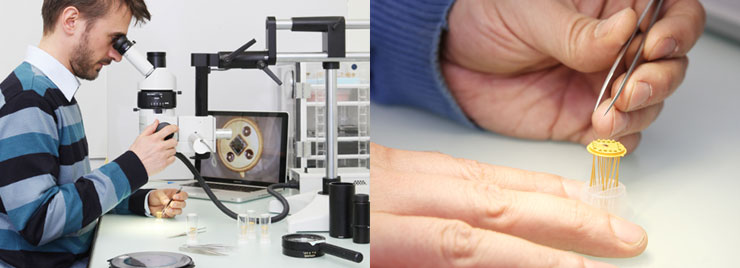Instrumentation
LEC has a vigorous instrumentation research and development program that has had much success due to a strong interaction between designers and users. The keystone of this program is the design, development & testing of advanced fast response probe technology. Through a number of collaborative efforts, LEC is using this technology to advance the development of next generation energy conversion devices in the field of turbomachinery, wind energy and laser produced plasmas. Furthermore, LEC is actively identifying emerging opportunities in interdisciplinary research where this instrumentation can enable knowledge generation and solve problems.
Over the last 20 years, high-frequency response aerodynamic probe (FRAP) measurement technique has been developed at the LEC. FRAP measures the steady, periodic and random components of the flow vector, which are derived from measurements of flow parameters including total and static pressures, flow angles, velocity components and Mach number. FRAP has advantages of high signal-to-noise ratio, high reliability, and are far more robust than hot wires. A number of custom-made FRAP probes with a single, double or multiple sensors have been developed in recent years, covering a wide range of turbomachinery applications: FRAP-ST provides the highest spatial resolution and measurement bandwidth; and FRAP-HT is equipped with piezoresistive sensors for high temperature applications. FRAP-7 sensors have been developed in the context of LEC’s wind energy research program and offer the largest flow angle measurement range under low dynamic head conditions.
The principal components of the miniature fast-response entropy probe (FENT) are a fast response aerodynamic probe and an unsteady total temperature probe based on the thin film technology. This design provides high spatial resolution, high temperature sensitivity, and robustness, which ensure that the measurements of the unsteady total temperature and the unsteady total pressure are over the same frequency range. This measurement capability allows entropy, the only means of quantifying aerothermal losses, to be directly inferred from measurements.
Coarse water droplets present in the last stages of low pressure (LP) steam turbines as well as atmospheric ice and sub-cooled water ingestion occurring in aircraft engines can result in undesirable engine operation due to blade fouling and erosion. In order to improve the efficiency and the lifetime of rotating components, the flow mechanisms that dominate particles’ motion need to be understood and correlated to the main engine’s operating flow field.
In that regard, a Fast Response Optical Backscatter probe (FRAP-OB) has been recently developed to measure the diameter and speed of coarse water droplets in particle laden flows. The probe is equipped with a red light laser which is focused through a set of optics, the probe measures the light scattered from each individual droplets passing across the focused laser beam using a fast-response photodiode place in the probe tip. The intensity of the backscattered light is directly proportional to the droplets’ diameter and the signal pulse width is used to derive of the droplets’ speed.
In order to enable unsteady flowfield measurements under wet steam conditions, the FRAP-HTH probe, which is an improved version of FRAP-HT, has been developed. The probe utilizes two miniature piezoresistive pressure transducers to measure flow angles as well as total and static pressures. In order to operate the probe without unclogging pressure taps and avoid any water contamination, the probe tip is heated. The probe tip temperature is controlled and maintained using a closed-loop PID regulator. The probe’s operation has been validated through extensive measurements conducted in the last stages of a multi-megawatt low-pressure steam turbine.
Instrumentation Facilities
LEC has several in-house state-of the-art calibration facilities: the sensor calibration facility, the aerodynamic calibration facility and the monodispersed droplet calibration facility. LEC is also equipped with a probe assembly lab for the manufacturing of MOEMS-based fast response probes and has full access to a state-of-the-art clean room facility.
The mono-dispersed droplet calibration facility is specifically designed for the calibration of the backscatter optical probe (FRAP-OB) that is used to measure coarse water droplets. A 2D-XY micrometric translation stage system enables accurate positioning of the probe in the train of droplets from an in-house developed droplet generator. Reference measurements of the droplets’ diameter are made with the shadow imaging technique.
The fast-response pressure sensor and aerodynamic probes are equipped with pressure die that require a static calibration. The static calibration is performed in an oven, that is used to calibrate piezo-resistive pressure sensors as well as thin film gages temperature sensors over a well defined pressure and temperature range. The probes are exposed to a low speed, isothermal air stream within a channel.
The air stream anneals the self-heating of the sensors and ensures that there is a homogeneous temperature field within the channel. Two thermocouples placed in close proximity to the probe are used to measure the temperature of the air stream. The calibration facility is pre-programmable and the data acquisition is fully automated.
LEC’s fully automated probe calibration facility, which is installed within an anechoic room, is used for the calibration of fast response aerodynamic probes and pneumatic probes. A free jet nozzle is used to calibrate the probes over a broad range of Mach numbers. Stepper motors are used to position the probe with six degrees of freedom. The three translational axes allow the distance between the probe tip and the nozzle exit to be adjusted. Since the probes are used for measurements in turbomachines or around wind turbines, a large range of angles with high spatial resolution must be covered; measurement are made at several hundred flow conditions in order to calibrate a probe. The computer-controlled calibration process is thus fully automated.
The sensor assembly laboratory is the probe and sensor development unit of our Lab. The laboratory consists of a closed low-dust facility with a filtered air supply creating laminar airflow over the tables and a slight overpressure inside the cabin compared to the surrounding area.
The infrastructure includes supplies of pressurized air, argon and nitrogen, as well as a vacuum pump, reference tables for the microscopes and a laboratory chapel. The major equipment incorporated in this facility are a vacuum oven, a normal oven for polymerization of glue and silicon hardening, three top-light microscopes. In addition to the sensor assembly lab, LEC has full access to the Binnig and Rohrer Nanotechnology Center (BRNC), a cleanroom facility located at IBM Zurich laboratories. BRNC is equipped with state-of-the-art equipment such as Physical Vapour Deposition tools (e-beam and sputtering systems) or sensor bonding tools (wedge and ball bonder, flip chip bonder).

